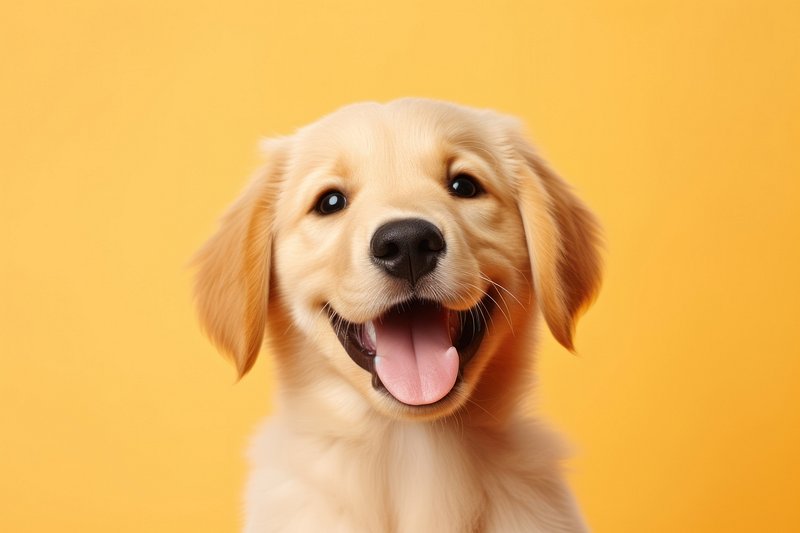Dogs are known for their loyalty, playfulness, and affection towards their owners. They are often described as man's best friend, and their ability to sense human emotions has been widely studied. But do dogs have a sense of humor? This question has been debated for years, and scientists and dog owners alike have attempted to answer it.

Canine Emotions and Humor One of the main reasons why people believe that dogs have a sense of humor is their ability to express emotions. Dogs are known to be playful, and they often make their owners laugh with their silly antics. They also have the ability to understand human emotions and respond accordingly, which suggests that they might be able to understand humor as well.
Behavioral Indicators of Humor There are certain behavioral indicators that dogs display when they are trying to be funny. For example, dogs might playfully nip at their owners or steal their socks as a way of teasing them. They might also make funny faces or noises, such as grunting or snorting, to get a reaction from their owners. These behaviors suggest that dogs might be trying to be humorous, but it is difficult to determine whether they are doing so intentionally or not.
Key Takeaways
- Dogs' ability to express emotions suggests that they might have a sense of humor.
- Certain behavioral indicators, such as playful nipping and funny noises, suggest that dogs might be trying to be humorous.
- While it is difficult to determine whether dogs are intentionally trying to be funny, their playful behavior is often interpreted as humorous by their owners.
Canine Emotions and Humor
Understanding Dog Emotions
Dogs are known to experience a range of emotions, just like humans. They can feel happy, sad, anxious, and even jealous. However, unlike humans, dogs cannot express their emotions through words. Instead, they communicate through body language, vocalizations, and behavior. Understanding dog emotions is crucial for building a strong bond with your pet and providing them with the care they need.

Sense of Humor in Dogs
Many dog owners believe that their pets have a sense of humor. They often describe their dogs as playful, goofy, and even mischievous. But do dogs really have a sense of humor? While there is no scientific evidence to prove that dogs can understand jokes or sarcasm, they do have the ability to experience joy and engage in playful behavior. This suggests that dogs may have a basic sense of humor, which is centered around playfulness and enjoyment.
Laughter and Playfulness
Laughter is often associated with humor, but it can also be a sign of playfulness and enjoyment. Dogs have been observed to make a sound that is similar to laughter, which is known as a "playful pant." This sound is often accompanied by a wagging tail, play bows, and other playful behaviors. While dogs may not understand jokes or sarcasm, they can certainly appreciate the joy and fun that comes with playfulness.
In conclusion, while dogs may not have the same sense of humor as humans, they do have the ability to experience joy and engage in playful behavior. Understanding dog emotions and providing them with opportunities for playfulness can help strengthen the bond between dogs and their owners.
Behavioral Indicators of Humor
Dogs are known for their playful and social nature, and many dog owners believe that their pets have a sense of humor. While it is difficult to prove that dogs experience humor in the same way as humans, there are several behavioral indicators that suggest dogs may have a playful and humorous side.
Play Behavior and Humor
Play behavior is a common indicator of a dog's sense of humor. Dogs often engage in play that involves teasing, chasing, and roughhousing with their owners and other dogs. This type of play is often accompanied by playful barks, growls, and other vocalizations that suggest the dog is enjoying the interaction.
One of the most common play behaviors that dogs engage in is the play bow. This is when a dog lowers its front legs and raises its hindquarters, often accompanied by a wagging tail. This is a clear indication that the dog is in a playful mood and is ready to engage in some playful interaction.
Vocalizations and Laughter
Dogs also use vocalizations to communicate their playful and humorous intentions. While dogs do not laugh in the same way that humans do, they do make a variety of vocalizations that suggest they are enjoying themselves.
One of the most common vocalizations that dogs make when they are playing is a panting sound. This is often accompanied by a wagging tail and other playful body language cues. Dogs may also make a variety of other sounds when they are playing, including barks, growls, and whines.
Body Language Cues
In addition to vocalizations, dogs also use body language cues to communicate their playful and humorous intentions. One of the most common body language cues that dogs use when they are playing is the play bow. This is when a dog lowers its front legs and raises its hindquarters, often accompanied by a wagging tail.
Dogs may also use other body language cues when they are playing, including jumping, spinning, and chasing. These behaviors are often accompanied by playful vocalizations and other signs that the dog is enjoying itself.
In conclusion, while it is difficult to prove that dogs have a sense of humor, there are several behavioral indicators that suggest they may enjoy playful interactions and engage in behaviors that are similar to those seen in humans when they are experiencing humor. By observing their play behavior, vocalizations, and body language cues, dog owners can gain a better understanding of their pet's playful and humorous side.
Scientific Perspectives
Historical Views on Animal Humor
The idea of animals having a sense of humor has been debated for centuries. Charles Darwin, who is well known for his theories on evolution, believed that animals do have a sense of humor. In his book, "The Expression of the Emotions in Man and Animals," he wrote about animals exhibiting behaviors that are similar to human laughter.

Contemporary Research Findings
Recent research has shown that dogs do have a sense of humor. A study conducted by Patricia Simonet, a researcher at the University of California-Davis, found that dogs can recognize when a human is laughing and will often respond with playful behavior. This suggests that dogs are capable of understanding and responding to humor.
Another study conducted by Stanley Coren, a professor of psychology at the University of British Columbia, found that dogs have a sense of humor similar to that of a 6-month-old human. This means that dogs are capable of understanding and enjoying simple jokes and playful behavior.
Expert Opinions on Canine Humor
Experts in the field of animal behavior have varying opinions on whether dogs have a sense of humor. Some believe that dogs are capable of understanding and responding to humor, while others believe that their behavior is simply a response to stimuli.
Overall, while the debate on whether dogs have a sense of humor is ongoing, recent research suggests that they do. Dogs are capable of recognizing and responding to human laughter, and they have a playful nature that suggests a sense of humor.
Differences Among Breeds
Breed-Specific Play Styles
Different dog breeds have different play styles, which can affect their sense of humor. For example, Poodles are known for their playful and energetic nature, while Dachshunds tend to be more independent and reserved. Cairn Terriers are known for their love of games and puzzles, while Pekingese dogs prefer quiet playtime with their owners.
Humor and Intelligence
Intelligence is also a factor in a dog's sense of humor. Breeds such as French Bulldogs and Boxers are known for their intelligence and ability to understand and respond to their owners' emotions. Siberian Huskies, on the other hand, are known for their independent nature and may not always respond to their owners' attempts at humor.
Breed Disposition to Humor
Some breeds have a natural disposition towards humor. For example, Beagles are known for their playful and mischievous nature, while Irish Setters are known for their love of fun and games. However, it's important to remember that each dog is an individual and may have their own unique sense of humor, regardless of their breed.
In conclusion, while breed-specific traits and intelligence can play a role in a dog's sense of humor, it's important to remember that each dog is unique and may have their own individual sense of humor.
Interactions with Humans and Animals
Dogs are known for their playful nature and their ability to interact with both humans and other animals. This section will explore how dogs respond to human emotion, the presence of humor in inter-species play, and how dogs use social play and jokes to communicate with others.

Dogs' Response to Human Emotion
Dogs are highly attuned to human emotion and can often sense when their owners are upset or anxious. They have been known to offer comfort and support to their owners during times of stress or sadness. Animal behaviorists believe that dogs have a unique ability to read human body language and facial expressions, which allows them to understand and respond appropriately to human emotion.
Humor in Inter-Species Play
Inter-species play between dogs and other animals, such as cats or birds, can often involve elements of humor. Dogs have been observed engaging in playful behaviors that resemble practical jokes, such as stealing toys or playfully nipping at their playmates. Animal behaviorists suggest that this type of play is a way for dogs to test boundaries and build social bonds with other animals.
Dogs' Social Play and Jokes
Dogs use social play and jokes to communicate with other dogs and humans. Social play involves behaviors such as chasing, wrestling, and play-biting, which help dogs to develop social skills and establish dominance hierarchies. Jokes, on the other hand, involve playful behaviors that are intended to elicit a response from another dog or human. For example, a dog may playfully steal a toy from another dog or hide an object from its owner, in an attempt to gain attention or provoke a response.
Overall, dogs have a complex and nuanced sense of humor that is closely tied to their social behavior and interactions with humans and other animals. By understanding how dogs use humor in their daily lives, we can gain a deeper appreciation for these beloved companions and the unique ways in which they communicate with the world around them.
Communication and Social Dynamics
Canine Communication Through Humor
Dogs communicate with each other in various ways, and humor is one of them. Playful teasing, funny noises, and silly actions are all forms of humor that dogs use to communicate with each other. For example, a dog might playfully bark at another dog and then run away, encouraging the other dog to chase after them. This type of playful interaction is a form of humor that helps dogs build social bonds and establish trust with each other.
Social Hierarchy and Play
Dogs are social animals and they have a natural instinct to establish a social hierarchy within their pack. Playful interactions, including humor, play an important role in establishing and maintaining this hierarchy. For example, a dominant dog might playfully growl at a subordinate dog to remind them of their place in the pack. This type of playful interaction helps dogs establish their social order in a non-aggressive way.
The Role of Humor in Bonding
Humor also plays an important role in bonding between dogs and their human companions. Dogs are highly social animals and they thrive on human interaction. By using humor, such as making funny noises or playing silly games, humans can establish a bond with their dogs that goes beyond basic obedience training. This type of bonding can help dogs feel more comfortable and secure in their environment, which can lead to better behavior and improved overall health.
In conclusion, dogs do have a sense of humor, and they use it to communicate with each other and with humans. Humor plays an important role in establishing social dynamics and bonding between dogs and their companions. By understanding the role of humor in canine communication, humans can build stronger relationships with their furry friends and provide them with a happy and fulfilling life.

Observing and Interpreting Dog Humor
Dogs are known to be playful and often engage in activities that can be interpreted as humorous. However, it is not always easy to identify and interpret their sense of humor. This section explores how to observe and interpret dog humor.
Identifying Playful Moods
Dogs often display playful moods when they are in the mood for humor. They may wag their tails, jump around, or initiate play with their owners. For instance, a Havanese may snuggle up to its owner and initiate a game of keep-away. Similarly, a Jack Russell Terrier may initiate a game of hide-and-seek by stealing an object and running away.
Interpreting Canine Jokes
Dogs often engage in behaviors that can be interpreted as jokes. For instance, they may engage in forced exhalation, which can be interpreted as a dog-laugh. They may also steal objects and run around with them, which can be interpreted as a game of keep-away. These behaviors can be interpreted as humorous, but it is important to keep in mind that dogs do not have the same sense of humor as humans.
Human Perception of Dog Humor
Humans often perceive dog humor in different ways. Some may find it amusing when a dog engages in playful behaviors, while others may not find it humorous at all. It is important to keep in mind that dogs have their own unique way of expressing humor, and it may not always align with human perceptions of humor.
In conclusion, observing and interpreting dog humor can be challenging, but with careful observation and interpretation, it is possible to identify and appreciate their playful behaviors. It is important to keep in mind that dogs have their own unique sense of humor, and it may not always align with human perceptions of humor.
Frequently Asked Questions
- What behaviors indicate a dog finds something humorous?
- Dogs have a unique way of expressing their emotions, including amusement and joy. Some behaviors that may indicate a dog finds something humorous include playful barking, tail wagging, and jumping around. Dogs may also exhibit a play bow, where they lower their front legs and raise their hind end, as a way of initiating play.
- Can dogs recognize laughter in humans?
- Studies have shown that dogs can recognize human emotions and respond accordingly. Dogs may be able to recognize laughter as a positive emotion and respond with their own playful behavior. However, it is important to note that dogs may also respond to other sounds or cues that may be associated with play.
- Do certain dog breeds exhibit a more noticeable sense of humor?
- There is no evidence to suggest that certain dog breeds exhibit a more noticeable sense of humor. However, individual dogs may have unique personalities and temperaments that may influence their ability to express amusement and joy.
- How do dogs express amusement or joy?
- Dogs may express amusement or joy through a variety of behaviors, including tail wagging, playful barking, jumping, and play bows. Some dogs may also exhibit a relaxed body posture, such as rolling over onto their back, as a way of expressing their happiness.
- Is there evidence to suggest dogs have favorite people or preferences?
- Research has shown that dogs may have a preference for certain individuals based on their past experiences and interactions. Dogs may also form strong attachments to their owners or other individuals who provide them with positive experiences, such as playtime or treats.
- In what ways do dogs show they understand playful interactions?
- Dogs may show they understand playful interactions by initiating play with other dogs or humans, responding to playful cues, and exhibiting playful behaviors such as play bows and jumping. Dogs may also learn to anticipate playful interactions and respond accordingly, indicating their understanding of the situation.






